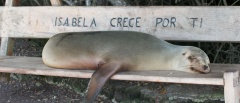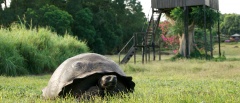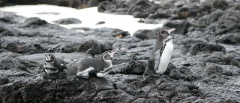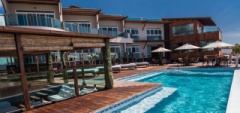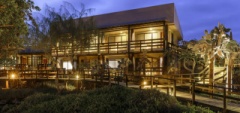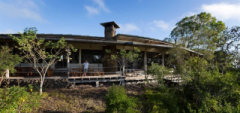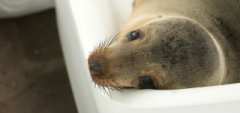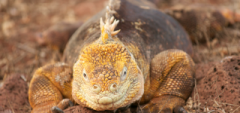The Galapagos Islands
The world-famous Enchanted Islands are a mecca for nature lovers...
This volcanic archipelago is synonymous with both the creature to which it is named after (Galápago is the old Spanish word for the Giant Tortoise) and the inspiration to Charles Darwin’s theory of evolution. Yet there is so much more to these mesmerizing islands than finches and the iconic tortoise. Located 960km off the Ecuadorian coast, The Galapagos consists of 13 islands and dozens of islets – forging a truly unique ecosystem with a dazzling array or wildlife and landscapes.
Many of the species here can be found nowhere else on Earth (known as endemic species); plus an abundance of other incredible lifeforms. Marvel at the comedic mating dance of the Blue-footed Boobies! Stroll amongst the endemic species of fur-seal, sea-lion and marine iguana; all of which can be found leisurely sunning themselves on the beach or pier. Spot our favourite endemic critter, the nippy Galapagos penguin – the only species of penguin found in a tropical climate. Of course, it is also impossible not to be charmed by the old timers of the islands – the eponymous Giant Tortoise.
The fun doesn’t stop on land. The waters around the Galapagos Islands are home to a myriad of biodiversity. Don your snorkel gear and plunge into a world of flamboyantly named sea-life: Spotted Eagle rays, Golden rays, Chocolate-chip sea stars, Hieroglyphic Hawkfish, Goatfish, Puffer fish, Trumpetfish, Parrotfish, Hogfish, Scorpionfish, Damselfish, Angelfish, Creole fish, Grunts, Moorish Idols, White-tipped Reef sharks and the obligatory endemic Galapagos shark! Head further out and spot a plethora of cetaceans, such as the Common and Bottle-nose dolphins, Orcas, Humpback, Fin and Bryde’s whales and even the heaviest bony-fish in the world – the Ocean Sunfish. Indeed, The Galapagos is renown across the globe as one of the finest SCUBA-diving destinations on the planet.
Let’s dispel a major myth about exploring the Galapagos: You do not have to spend your entire stay on a boat! Galapagos cruises are, with good reason, a popular way to see the islands. We feel this is a special experience and gives you access to parts of the archipelago that you wouldn’t otherwise be able to visit. However, for those who do not have the stomach or inclination to spend several days & nights at sea, rest assured you can have an incredible trip and still be tucked up safely on terra firma each night. Land-based itineraries that feature half-day or full-day excursions by boat are also a great way to discover the Galapagos.
There are 3 islands that are permanently inhabited and offer accommodation and excursions. Click below to read more on Santa Cruz, San Cristobal and Isabela. All three have airports, allowing inter-island flights between the three. However, only Santa Cruz (Baltra island airport) and San Cristobal have direct flights back to the mainland (to Quito or Guayaquil). It is also possible to take boat transfers between the islands. However, it is worth noting that these can be a touch nauseous and also take significantly longer: From Santa Cruz to Isabela and San Cristobal is 2 ½ hours and 2 ¼ hours respectively by boat; as opposed to around 30-40 minutes by air in an 8-seater plane.
Below is an overview of the main islands of the Galapagos archipelago:
Isla Santa Cruz
The busiest and most populated of the islands, with nearly all the action found in Puerto Ayora – the main port of the Galapagos – at the southern end of the island. This is where the majority of boats and yachts (for both daytrips and cruises) will start/finish their excursions. The town is also a hive of activity, home to a plethora of restaurants, hotels, bars, souvenir shops and countless sea lions! Puerto Ayora is also where the renowned Charles Darwin Research Station is located. The pick of the properties here is the resplendent Finch Bay Hotel. However, there is so much more to Santa Cruz. The highlands offer a wonderful contrast to the hubbub of Puerto Ayora – packed with misty forests, cavernous lava tubes to explore and wildlife reserves of free-roaming tortoises in their natural environment. For those after some peace and quiet, take your pick from the stunning properties nestled away in the highlands - the Royal Palm, the Galapagos Safari Camp or Pikaia Lodge.
Isla de San Cristobal
The eastern-most island and second most populated. Like Santa Cruz, most of the activity is based in the capital of the island – Puerto Baquerizo Moreno. The town’s airport also offers direct flights to both the mainland (Quito and Guayaquil) and other islands (Baltra and Isabela). Whilst Puerto Baquerizo Moreno in far less thriving than Puerto Ayora, it remains a charming place to spend a couple of nights soaking up the relaxed seaside promenade. Our pick of where to stay is hands-down the Golden Bay Galapagos Hotel. The island also features some excellent daytrips, such as snorkeling at Kicker Rock and Lobos; or walk amongst the tortoises at the Galapaguera de cerro Colorado reserve/breeding centre.
Isla Isabela
By far and away the largest of the islands, Isabela has more land mass than the rest of the Galapagos combined! Yet despite its size, the island remains relatively underdeveloped. This in part is due to its composition – being made up of 6 volcanoes means most of Isabela is inaccessible due to the geology and dense vegetation. The capital, on the south shore, is Puerto Villamil; which also has a small airport for links to Baltra and San Cristobal. To describe Puerto Villamil as a ‘sleepy town’ would be an understatement! Yet we feel this epitomizes the island’s charm. What is lacks in infrastructure it more than makes up for in tranquility and stunning beaches. Excursions to Las Tintoreras and Los Tuneles both present brilliant snorkeling opportunities for an array of wildlife – including the Galapagos penguin! For a beach-front stay, the Iguana Crossing Hotel or the Albemarle Hotel are the best options. For those after something a bit different, head to Scalesia Lodge for a spot of glamping in the highlands.
Baltra
Sometimes confused with being part of Santa Cruz, this islet lies to the north of Santa Cruz, across the Itabaca canal (a 10-minute crossing by water taxi). The chief purpose now is the airport which is the primary access point to the Galapagos Islands from the mainland. The airport runs off renewable energy and was awarded LEED Gold status by the US Green Building Council. Once across the canal, the drive to Puerto Ayora is just under an hour.
Isla Fernandina
Just a few kilometres west of Isabela, Fernandina is the youngest of the Galapagos Islands and the most volcanically active – with five eruptions since the turn of the century. Arguably the best place in the Galapagos to see the flightless Cormorant, and good for the penguins. Fernandina can only be accessed via multi-day cruises, likewise the north and west coasts of Isabela. The waters of the area are excellent for whale and dolphin watching.
Isla Española
This is the only island in the Galapagos where you can find the Waved Albatross, and even then, only from April to December. The species of marine iguana and lava lizards can be found nowhere else on the planet. Española can only be reached as a daytrip from San Cristobal, or as part of a multi-day cruise.
Isla Genovesa
Another ‘must-do’ for any twitchers – the birdlife on Genovesa is overwhelming. The island cannot be reached as a daytrip and so to visit it must be included in the itinerary of a cruise. For fans of our feathered friends, it is a worthy reward. The absence of any alien species and only a few reptiles (including the smallest marine iguana of the archipelago) has resulted in a habitat where the birds rule supreme. Genoseva has the largest colony of red-footed Boobies on the planet. Visitors can also spot Nazca Boobies, short-eared owls, Frigatebirds, mockingbirds, storm petrels, red-billed tropicbirds, yellow-crowned night herons, vampire finches and many, many more!
Isla Floreana
Located to the south of Santa Cruz, Floreana is popular, being accessible for both cruises and as a daytrip. It is the best place to see Flamingos in the Galapagos and offers great snorkeling and diving at Devil’s crown. Floreana’s other claim to fame is the ‘postbox’ in Post Office Bay. In the 18th century, whalers would leave letters for their families here, which would be picked up by homeward-bound sailors to deliver – as random acts of kindness. To this day, you can leave unstamped postcards for your loved ones here and hope that a fellow traveler will check the address and do the good deed. The postcard I left here arrived home a week after I did!
Isla Darwin & Isla Wolf
These two islands are visited for just one reason – SCUBA diving. These two tiny islands (approx. ½ square mile each) are located nearly 200 miles north of Santa Cruz. The Galapagos Islands rightfully have a reputation as being one the best diving locations on Earth; but Darwin & Wolf really is the best-of-the-best. However, strong currents make this a site for experienced, advanced-qualified divers only. The islands can only be reached via week-long liveaboard cruises, and half of this time is spent getting there and back! Nevertheless, it is 100% worth it. Darwin & Wolf is teeming with sea-life and especially shark species – Hammerhead, Reef, White-tipped, Galapagos, Silky and (from June – November) the mighty Whale shark; as well as turtles, dolphins, rays and countless fish species.
The other islands
There are numerous other islands, mostly found in close proximity to Santa Cruz, which can be reached as daytrips and provide a fantastic range of the Galapagos’ wildlife. These include Isla Santiago, Bartolome (where the iconic photo of Pinnacle Rock can be taken), Isla Rabida, Seymour Norte, Chinese Hat (Isla Sombrero Chino), Isla Pinzon and Isla Santa Fe. The remaining islands are protected and strictly off limits to tourists.

